MV Dirona travel digest for Brisbane 2014

|
Click the travel log icon on the left to see these locations on a map,
with the complete log of our cruise. On the map page, clicking on a camera or text icon will display a picture and/or log entry for that location, and clicking on the smaller icons along the route will display latitude, longitude and other navigation data for that location. And a live map of our current route and most recent log entries always is available at //mvdirona.com/maps/LocationCurrent.html. |
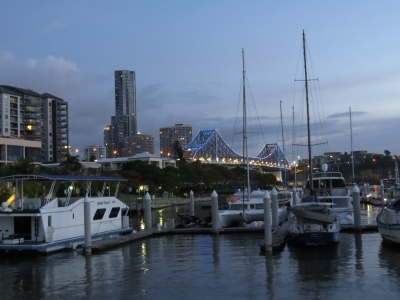 |
5/23/2014: Dockside Marina
Position: -27°28.24'S, 153°2.32'E
We have an awesome berth at Dockside Marina with a view to Story Bridge and downtown Brisbane. We ran upriver from Rivergate to Dockside at night, and had to pay careful attention at the helm. Like most big cities, there's lots of light, but that means lots of backlight. Brisbane also makes heavy use of its waterway, with high-speed catamarans constantly crisscrossing the river. Locals estimate the current was running at 2-3 knots when we arrived at Dockside, which required considerably more care than usual when entering the slip.
|
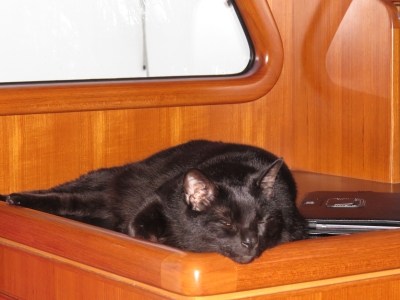 |
5/23/2014: Relaxing
Position: -27°28.24'S, 153°2.32'E
Spit didn't seem to mind the crossing, but he sure looked happy to be moored.
|
 |
5/23/2014: Gray Matter
Position: -27°28.24'S, 153°2.32'E
Moored beside our friends Mark Mohler and Christine Guo on N62 Gray Matter. It's been a long time, and a lot of miles between us, since we first moored together in the San Juan Islands in the summer of 2011. We later spent time with them at their homeport of Westpoint Harbor Marina in San Francisco. We all left California in late 2012, and after a few meetings across the South Pacific, are together again in their new home port of Brisbane.
|
 |
5/23/2014: Bunnings Wharehouse
Position: -27°28.40'S, 153°5.84'E
Mark drove us over to Bunnings Wharehouse to pick up a few supplies. We'd mostly been to smaller downtown stores in New Zealand--this was the first time since Honolulu that we'd gone to a warehouse-sized store--it felt cavernous.
|
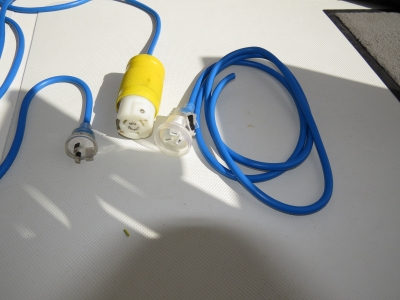 |
5/23/2014: Power adapter
Position: -27°28.24'S, 153°2.32'E
One of the items we needed at Bunnings was a local 15-amp, 240V power plug, and some more small wire to build a pigtail adapter with. We opted to buy a 30-meter outdoor extension cord, and just replaced the female end with an adapter that matches our boat's power connection. This way we can run a small cable along the dock and keep our larger, permanent boat cable out of the weather.
|
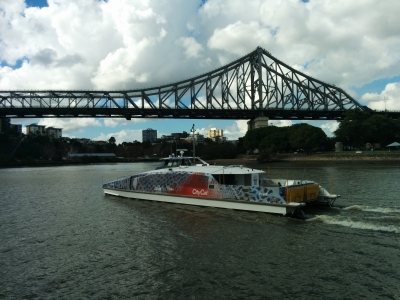 |
5/23/2014: Story Bridge
Position: -27°27.89'S, 153°2.27'E
A free ferry leaves every half-hour for downtown Brisbane from a pier adjacent to Dockside Marina. This is one of the dozens of fare-based high-speed catamarans that ply the river, as we near Story Bridge.
|
 |
5/23/2014: Downtown Brisbane
Position: -27°28.03'S, 153°1.93'E
View from the ferry to downtown Brisbane, known as the CBD (central business district).
|
 |
5/23/2014: Riverbar Kitchen
Position: -27°28.09'S, 153°1.86'E
Lunch outdoors at the Riverbar Kitchen, one of at least a dozen restaurants that overlook the river in downtown Brisbane. We're just loving it here.
|
 |
5/23/2014: Telstra
Position: -27°28.20'S, 153°1.41'E
At the Telstra store to pick up a cell phone SIM card.
|
 |
5/23/2014: Citibank
Position: -27°28.18'S, 153°1.52'E
Opening a local bank account at Citibank. When we're going to be in a country for a while, this allows us to pay local bills more easily, and also withdraw cash without any international transaction fees (we had a local account in New Zealand at Kiwibank). Mark Mohler of N62 Gray Matter, center in the picture above, suggested Citibank because funds can be electronically transferred quickly and without fee from a US Citibank account.
|
 |
5/24/2014: Farmers market
Position: -27°28.13'S, 153°3.25'E
We took the ferry across the river with Mark and Christine and walked to the excellent Brisbane Powerhouse Farmers Market. The market sets up at Powerhouse Plaza, the site of an old power station that now is a contemporary arts center.
|
 |
5/24/2014: Satellite TV
Position: -27°28.24'S, 153°2.32'E
James climbed the stack to switch the Low Noise Block (LNB) at the satellite television antenna. Circular LNBs are used in the US, Canada, Latin America and some parts of Asia. Linear LNBs are used in Mexico, Europe, Australia and New Zealand. We haven't used the satellite TV system since Hawaii, so the circular LNB was still installed. This is only the first of a multi-stage process: we also need a local satellite decoder and a PAL-to-NTSC converter. PAL is the video standard used outside the Americas--all our AV equipment requires NTSC.
|
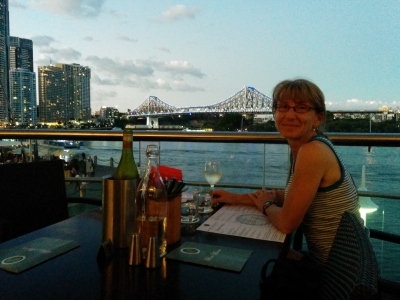 |
5/24/2014: Jade Buddha
Position: -27°28.17'S, 153°1.85'E
Dinner at the Jade Buddha, with an awesome view of the Brisbane River and Story Bridge.
|
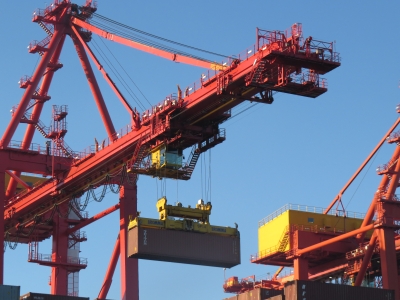 |
5/25/2014: Port of Brisbane
Position: -27°21.96'S, 153°10.36'E
Nordhavn 5267 was arriving on the AAL Hong Kong, expected into port last night. We went down in the dinghy to have a look, but the ship had anchored off for a day, probably waiting for mooring space. Pictures from the delivery of 5267 are here.
|
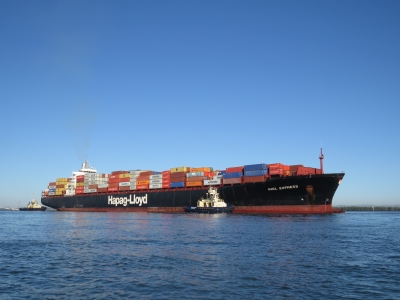 |
5/25/2014: Kiel Express
Position: -27°22.28'S, 153°10.22'E
Tugs assisting the Kiel Express off the dock.
|
 |
5/25/2014: Svitzer Colmslie
Position: -27°22.28'S, 153°10.22'E
The Svitzer Colmslie, one of the tugs assisting the Kiel Express, charging upriver after the job is complete.
|
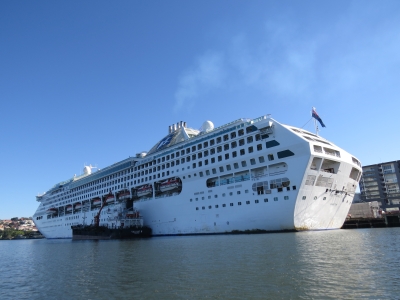 |
5/25/2014: Sea Princess
Position: -27°26.55'S, 153°4.16'E
The cruise ship Sea Princess docked alongside the Brisbane River. The clearance under the GateWay Bridge, just downstream looked quite tight--we were suprised the ship could make it under. It turned out to be closer than we could have guessed: the ship's height and the bridge clearance are both listed as 188 feet.
|
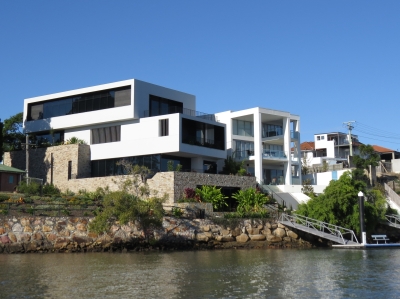 |
5/25/2014: Beautiful homes
Position: -27°28.58'S, 153°2.71'E
Many beautiful homes line the Brisbane River.
|
 |
5/25/2014: Dockside Marina
Position: -27°28.35'S, 153°2.42'E
View across Dockside Marina to downtown Brisbane, from just downstream of the marina.
|
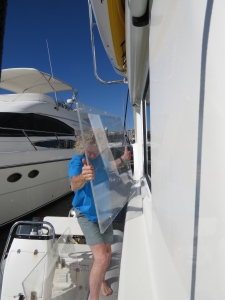 |
5/25/2014: Storm plates
Position: -27°28.24'S, 153°2.32'E
With the dinghy down, we removed the storm plates that we had on for the run across the Tasman Sea.
|
 |
5/25/2014: Boat wash
Position: -27°28.24'S, 153°2.32'E
Even in the calm conditions we'd had crossing the Tasman, saltwater fills the air and gets everywhere. While we weren't nearly as coated as after some crossing, Dirona still needed a good wash.
|
 |
5/27/2014: CityCat
Position: -27°28.49'S, 153°2.54'E
Leaving the Sydney Street dock on a CityCat as another arrives behind us.
|
 |
5/27/2014: Kangaroo Point Cliffs
Position: -27°28.57'S, 153°2.00'E
A bicycle and pedestrian path runs along much of the river in this area, with sculptures, rest points, parks and restaurants along the way.
|
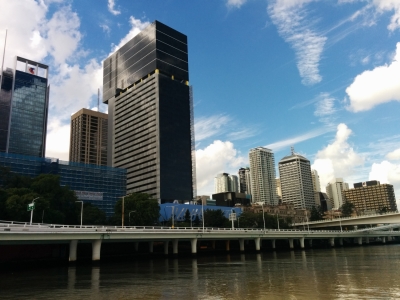 |
5/27/2014: Brisbane CBD
Position: -27°28.26'S, 153°1.22'E
Looking back to Brisbane Central Business District from just north of the Victoria Bridge.
|
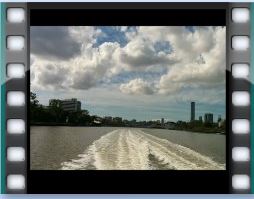 |
5/27/2014: Orleigh Park
Position: -27°29.00'S, 152°59.86'E
The view looking back and forward as the cat runs past Orleigh Park to port.
|
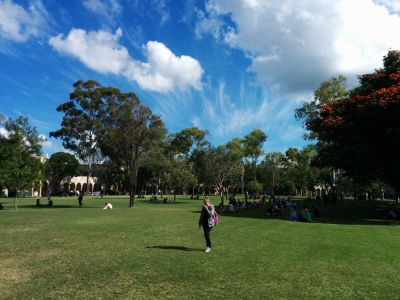 |
5/27/2014: The Great Court
Position: -27°29.81'S, 153°0.86'E
Looking west across the Great Court at the University of Queensland. The campus is beautiful, and reminded us of Stanford. Christine Guo of N62 Gray Matter was on campus that day and invited us to visit. Christine works at the Queensland Institute of Medical Research, and frequently is on campus to collaborate with the researchers there.
|
 |
5/27/2014: 7 Tesla
Position: -27°30.02'S, 153°0.73'E
Christine introduced us to Markus Barth, head of the 7 Tesla Research Program at the university's Centre for Advanced Imaging. The 7 Tesla is one of the best MRIs in the world, and produces incredibly detailed images. The 7 refers to the field strength--most clinical MRIs are 1.5 to 3 Tesla. Markus showed us their 7 Tesla and gave us a great description of how it worked. Thanks Christine and Markus!
|
 |
5/27/2014: Lake
Position: -27°29.92'S, 153°0.95'E
A impressive lake is on campus, with a beautiful fountain and much bird life.
|
 |
5/28/2014: Calm Dental
Position: -27°28.24'S, 153°2.58'E
We got a recommendation for a good dentist in the area, and we're both due for cleaning and a checkup.
|
 |
5/28/2014: Hydraulic leak
Position: -27°28.24'S, 153°2.32'E
We keep our bilge clean, so even the smallest problem can be spotted right away. On our boat, a leak anywhere quickly ends up in the main bilge, making detecting even the smallest leaks easy. James found a bit of hydraulic oil in the main bilge and traced down the problem to the forward thruster area. The leak location was hard to find, so James put the forward thrusters on using the remote helm control and a thin jet of hydrualic oil hit him in the forehead. I think he said "I found it", or something like that. :) The fix was a five-minute job: an aged o-ring had failed.
|
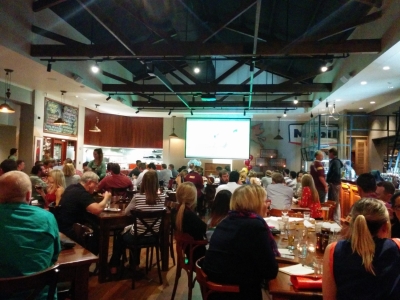 |
5/28/2014: State of Origin
Position: -27°28.13'S, 153°2.13'E
At Deery's Restaurant in the Story Bridge Hotel to watch the first 2014 State of Origin rugby league match. The best-of-three series between states Queensland and New South Wales is among the most popular sporting events in the country--the series name reflects player eligibility based on the state where they originally played senior rugby league. Queensland lost, but the match was excellent. We'll also be in town for the other two matches.
|
 |
5/30/2014: Tug and barge
Position: -27°28.24'S, 153°2.32'E
Tug bringing a barge downriver from a nearby construction site--the city is rebuilding a bicycle and pedestrian bridge that runs along the river opposite the marina. A major flood in 2011 destroyed the previous bridge.
|
 |
6/1/2014: City Roos
Position: -27°28.23'S, 153°1.39'E
Two of the four wonderful recycled-metal sculptures in Chris Trotter's City Roos collection. We discovered them on a walk around the downtown area.
|
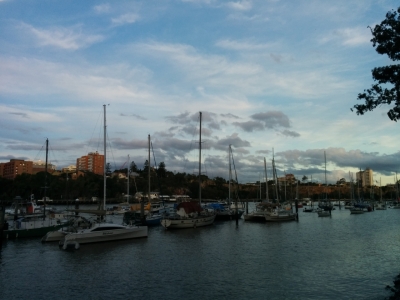 |
6/1/2014: Pile moorings
Position: -27°28.36'S, 153°1.85'E
Looking east across the pile moorings near the Botanical Gardens.
|
 |
6/1/2014: Goodwill Bridge
Position: -27°28.79'S, 153°1.67'E
Crossing the river on the popular Goodwill pedestrian and bicycle bridge.
|
 |
6/1/2014: Carpentaria
Position: -27°28.91'S, 153°1.55'E
Looking down from the bridge to the former lightship Carpentaria at the Queensland Maritime Museum. The ship is mounted inside an old drydock.
|
 |
6/1/2014: Sunset
Position: -27°28.69'S, 153°1.43'E
Sunset with the Wheel of Brisbane lit up at the left of the photo.
|
 |
6/1/2014: The Jetty
Position: -27°28.84'S, 153°1.51'E
An excellent meal at The Jetty with a view across the river to the Central Business District (CBD).
|
 |
6/2/2014: River survey
Position: -27°28.59'S, 153°1.93'E
Mobile jackup rig platform used for surveying the river bottom. We'd seen it a few times from shore or ferry, but got a closer look as we passed on a dinghy tour upriver.
|
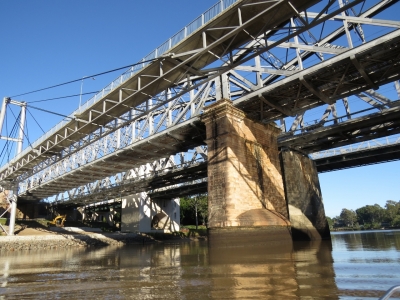 |
6/2/2014: Bridges
Position: -27°30.34'S, 152°58.43'E
An unusual sight: four independent bridges span the river between Indooroopilly and Chelmer reaches. The center two are for rail, the far one is for vehicles, and one closest to us is for pedestrains and bicycles.
|
 |
6/2/2014: Helicopter
Position: -27°31.63'S, 152°56.49'E
Beautiful homes line the river. This one was the most unusual with a helicopter "crashed" into the back deck.
|
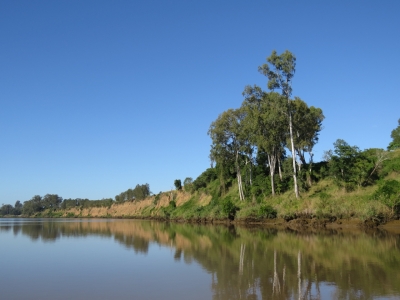 |
6/2/2014: Cockatoo Island
Position: -27°35.06'S, 152°53.72'E
Red cliffs opposite Cockatoo Island--we were 22 miles upriver from our marina at this point. Brisbane's residential outskirts had faded to nothing and we were looking south into a rural landscape.
|
 |
6/2/2014: Cable ferry
Position: -27°35.71'S, 152°51.40'E
We started seeing warning signs about a cable ferry and rounded the bend to find the Moggill Vehicle Ferry crossing the river. Cables strung across the river pull the ferry from one side to the other--we had to wait for the ferry to dock and slacken the cables before we could proceed upriver.
|
 |
6/2/2014: Navigation mark
Position: -27°32.26'S, 152°51.02'E
The river has been quite wide and deep the whole way, with the occasional navigation marker where a hazard exists.
|
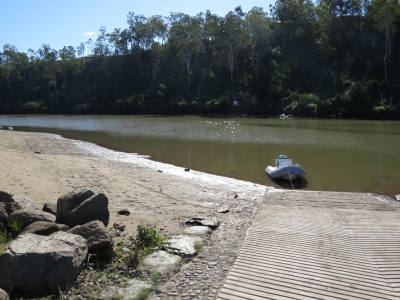 |
6/2/2014: Kookaburra Park
Position: -27°32.55'S, 152°50.47'E
We landed the dinghy on the launch ramp at Kookaburra Park for a quick walk ashore. Several nice parks are along the river, and we'd considered landing at a few others, but none had docks and the river mud was too thick along the shore. This ramp was comparatively clean, but we still brought a fair bit of mud on board.
|
 |
6/2/2014: Flood debris
Position: -27°32.62'S, 152°50.50'E
This dock likely was wedged into the trees during the 2011 flood.
|
 |
6/2/2014: Johnsons Rocks
Position: -27°33.23'S, 152°49.35'E
This is pretty much the end of the navigable waterway and we found the rocks to prove it. Signs at Kookaburra Park warned that there was shoaling beyond. About a mile upriver, we were running center-channel and found rocks. We've touched bottom countless times in the dinghy, but never this hard, and the prop was in pretty rough shape.
|
 |
6/2/2014: Prop repair
Position: -27°32.98'S, 152°49.50'E
James bending the propeller back into some shape resembling normal.
|
 |
6/2/2014: Refueling
Position: -27°30.64'S, 152°58.02'E
We'd run 40 miles upriver on less than a half tank of fuel. On the return run, the current had turned to strongly against us, but we still had fuel to spare. About halfway back downriver we realized we had a big problem: because the prop was so bent up, the fuel efficiency had been incredibly poor. By the time we noticed it, making the full trip without more fuel was in doublt. It's surprising that 40 miles of busy riverway could not have a single fuel stop, but having made the trip upriver, we knew that to be the case. This dock-maintenance and pile-driving rig passed us going upriver and they we able to give us the couple of gallons we needed to know we could make the trip back.
|
 |
6/2/2014: Dinghy prop
Position: -27°28.24'S, 153°2.32'E
James is pretty good at straigtening props and getting another year out of them (he's had a lot of practice), but this one's done it's last trip.
|
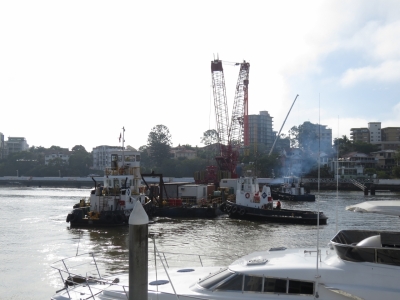 |
6/3/2014: Cranes
Position: -27°28.24'S, 153°2.32'E
Tugs moving barge-mounted cranes to work on the bicycle/pedestrian bridge. Major equipment moves like this happen almost every day.
|
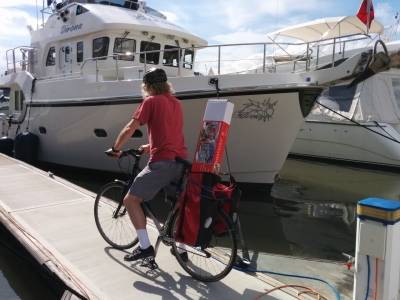 |
6/4/2014: Heatstrip
Position: -27°28.24'S, 153°2.32'E
We biked out to Bunnings today to pickup a Heaststrip outdoor radiant heater. We missed the warmth of the propane heater we'd had on the previous boat and had been looking for a non-propane alternative. We've been interested in Australian-made low-profile Heatstrip model since first seeing one in Akaroa, NZ.
|
 |
6/4/2014: Testing the heater
Position: -27°28.24'S, 153°2.32'E
Before purchasing the heater, we'd checked with the manufacturer for compatibility with our boat's 60Hz power. They said it would run on 50 or 60Hz, but all the documtenation that came with it indicated 50Hz only. We have no 240-volt outlets, so James temporarily wired it into the 240-volt system to test it. He used the leftover end of the extension cord we'd adapted for shore power, and ran an extension cord to the heater outside on the foredeck.
|
 |
6/5/2014: Mounting the heater
Position: -27°28.24'S, 153°2.32'E
Working on the mounting location for the heater. One advantage of this unit is it radiates heat unidirectionally, and so can be mounted quite close to an overhead surface.
|
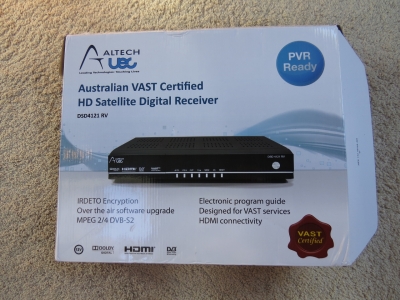 |
6/6/2014: Satellite reciever
Position: -27°28.24'S, 153°2.32'E
The next stage in getting our satellite TV system working arrived today: an Australian digital receiver.
|
 |
6/7/2014: Reprogramming
Position: -27°28.24'S, 153°2.32'E
And the third stage in our quest for satellite TV: the satellite frequencies had changed since our system was installed, so we needed to reprogram them into the satellite dish. This allowed the receiver to find the satellite, but we still need a PAL-to-NTSC converter to play the PAL output from the local receiver on our NTSC equipment.
|
 |
6/8/2014: Dinghy maintenance
Position: -27°28.24'S, 153°2.32'E
Greasing the lift, trim and steering on the dinghy.
|
 |
6/8/2014: Magpie-lark
Position: -27°28.24'S, 153°2.32'E
Magpie-larks are common throughout most of Australia. They are aggressively territorial and will attack larger birds and even people to defend their territory. This female hopped into the boat and briefly into the salon before losing interest and heading back outside.
|
 |
6/9/2014: Slime
Position: -27°28.24'S, 153°2.32'E
Many of the marinas we've stopped at are exposed to swell, or wash from other boats. Large fenders are essential to avoid boat damage, but take a lot of space to store. We use Aere inflatables--we have 2 24"x42", 6 18"x29" and 4 12"x72". At dock, we usually put a 24x42 near the pilothouse and 3 18x29s farther aft. We really like the fenders, especially the big one forward, and they have taken a lot of abuse, but they haven't lasted as well as we'd like. We've repeatedly fixed leaks at the seams, and lately several won't hold full pressure no matter what we do. So we're trying Slime tire sealant to see if we can extend their life.
|
 |
6/10/2014: Tank lock
Position: -27°28.24'S, 153°2.32'E
We added rings to the necks of our scuba tanks so we can lock them to the boat with a cable.
|
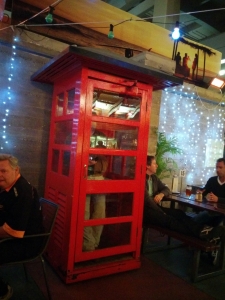 |
6/10/2014: Phone booth
Position: -27°28.13'S, 153°2.13'E
Phone booth at the Story Bridge Hotel. People go inside to talk on their cell phones.
|
 |
6/11/2014: Pig 'N' Whistle
Position: -27°28.12'S, 153°1.60'E
Lunch at the Pig 'N' Whistle British pub after a morning of shopping at the Queen Street Pedestrian mall in the background.
|
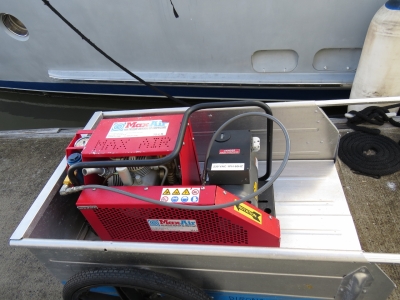 |
6/12/2014: Scuba compressor
Position: -27°28.24'S, 153°2.32'E
Our Max-Air scuba compressor failed today after only 50 hours. On the previous boat, we had a gas-powered Max-Air unit that worked well, and that's one of the reasons we went with the Max-Air electric version for the current boat. But we've been pretty unhappy with this compressor, and Max-Air's customer service. We contacted the manufacturer for an online manual since we don't like to keep paper copies on the boat to save weight and space. Max-Air was unwilling to give us an electronic copy and wanted to charge $30 to replace our paper copy that had been water-damaged in shipping. Fairly early in the life of the compressor, when we first went to change the breathing air filter, James was unable to get it off and called Max-Air service for advice. They instisted James must have overtightened it. When he explained that we'd never had it off and this was the first filter change, Max-Air service didn't believe him and refused to help. We later figured out that if the air filter housing isn't fully drained of pressure, it won't come apart. An easy fix, but not a good customer-service experience. The compressor now is no longer able to pump past 3,000 PSI and it appears it will need a complete overhaul or replacement after only 50 hours. We've heard so many good stories about Bauer Junior compressors and so many problems from others using Max-Air that we're tempted to replace it even if it's possible to rebuild it. The money we saved buying the Max-Air doesn't look like such a good decision now.
|
 |
6/13/2014: TV test
Position: -27°28.24'S, 153°2.32'E
Mark Mohler of N62 Gray Matter next door lent us his PAL-format television so we could test our satellite TV setup end-to-end. Our PAL-to-NTSC converter should arrive soon and we wanted to make sure everything was working up to the point of the conversion. Spitfire seemed to be particularly missing TV.
|
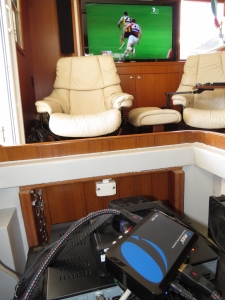 |
6/13/2014: And we have TV!
Position: -27°28.24'S, 153°2.32'E
The PAL-to-NTSC converter arrived today, and amazingly, it just worked. And, equally amazing, Amazon shipped the unit to Brisbane from the US in less than two weeks for only $8 shipping. To get our satellite TV system working in Australia, all we had to do was 1) climb the stack and swap in the linear low noise block (LNB), 2) manually adjust the LNB skew, 3) program the new satellite frequencies into the dish, 4) install a local Australian decoder, and 5) install a PAL-to-NTSC converter. Basically plug-and-play :).
|
 |
6/14/2014: Bike Butler
Position: -27°28.24'S, 153°2.32'E
We're really happy with our Giant FCR-2 bikes--they have been our daily wheels for six years now. The bikes have never lived inside, spending their entire lives on the swim platform of our boat, outdoors at marinas and up on our flybridge for ocean crossings, sometimes in really rough weather. How they can be running at all after all this is a mystery to us. Nonetheless, they continue to run extremely well, show little rust, and don't require much service. Recently James' bike developed a headset bearing problem. When a bike is your only form of transportation, it's a bit of a hassle to get them fixed unless the repair shop is willing to do it while you wait. We found an even easier solution in Brisbane: we called The Bike Butler. Amos came by, picked up the bike and it had back the same evening. When he dropped it off, not only was the headset bearing replaced and working beautifully, but he'd also cleaned the bike and replaced one break cable and case for no extra charge. An amazing service--if you live in Brisbane, you've got to use it.
|
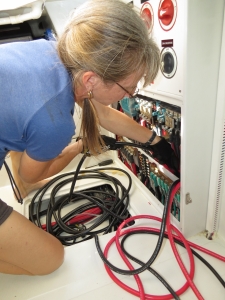 |
6/15/2014: Charger cables
Position: -27°28.24'S, 153°2.32'E
We made a decision when the boat was being built to move the two 100-amp Mastervolt chargers from the port to the starboard side of the lazaratte. This would give them a nice, guaranteed dry location away from the overhead cockpit hatch. Unfortunately, the starboard side is a lot further away from the DC panel and the 2-gauge cable originally specified for the port side actually is undersized for the longer run. As a consequence, the cable runs hotter than we like and the Mastervolt system occasionally alerts on the voltage drop caused by the undersized cable. This issue is one of those problems that are hard to tackle because on the one hand the issue is fairly small, and on the other hand making the cable change is an enormous amount of work. We like things right, so we replaced the 2-gauge cables with 0-gauge. That's 40lbs of new copper we're trying to pull through already overstuffed wireways: an entire day of fun, skinned knuckles and sore arms. But it sure is nice to see the system running perfectly.
|
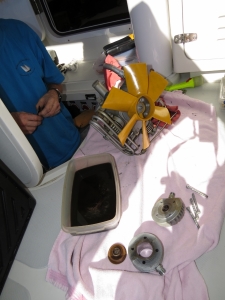 |
6/17/2014: Fourth stage
Position: -27°28.24'S, 153°2.32'E
The Max-Air compressor torn down. The fourth stage top ring had siezed, the second ring is broken up and the pistons and ring are badly scored. Unfortunately, some parts of the broken ring have fed down below, likely doing further damage, and the oil is black. We strongly suspect that a new fourth stage piston and cylinder would get the system operating again, but we really need something more reliable.
|
 |
6/17/2014: Divetek
Position: -27°28.24'S, 153°2.32'E
Daryl Waters, of Divetek Brisbane, and James surveying the compressor mount for the installation of a Bauer Junior.
|
 |
6/17/2014: Wire run
Position: -27°28.24'S, 153°2.32'E
We are running a new control wire between the pilothouse and a relay in the DC panel. Here we've got the wire from the pilothouse down through the wire run at the bottom of the stateroom stairs and under the master stateroom floor. Then we'll run it under the master stateroom berth and through the engine room all the way aft to the DC panel in the lazarette.
|
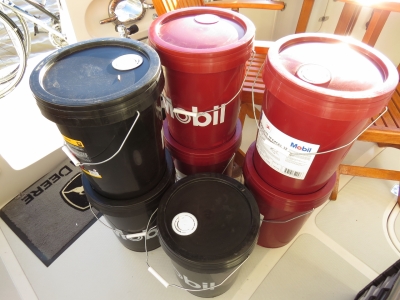 |
6/18/2014: Oil
Position: -27°28.24'S, 153°2.32'E
East Coast Lubes just delivered 160 liters of oil.
|
 |
6/18/2014: Drydock
Position: -27°28.36'S, 153°2.24'E
This section of the Dockside Marina is known as the Drydock because that's what it used to be. After the 2011 flood, it's now pretty much useless for moorage.
|
 |
6/18/2014: Ideal Electrical
Position: -27°28.84'S, 153°2.48'E
At Ideal Electrical picking up more supplies for the various electrical projects we've got underway.
|
 |
6/18/2014: Key recovery
Position: -27°28.25'S, 153°2.30'E
In cryptography key recovery can be a difficult problem, and we've learned in the boating world it's not much easier. Here James is recovering the keys he dropped in the water several days ago--we noticed them sitting in the mud as we passed by at low tide.
|
 |
6/18/2014: Story Bridge
Position: -27°27.77'S, 153°2.15'E
View downriver from Story Bridge. We'd taken our bikes on the ferry across the river to New Farm and cycled back across the bridge.
|
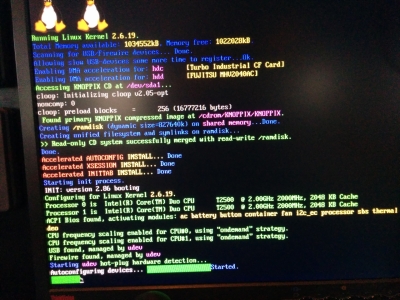 |
6/18/2014: Software update
Position: -27°28.24'S, 153°2.32'E
The new NavNet 3D software handles AIS targets slightly better, so we're installing it now.
|
 |
6/18/2014: State of Origin
Position: -27°28.24'S, 153°2.32'E
We watched the State of Origin Game II on our newly-operating satellite TV system. The game was exciting and close, but Queensland unfortunately lost the second match as well.
|
 |
6/19/2014: Barge
Position: -27°28.24'S, 153°2.32'E
The crane barge, used to lift prefab cement pieces for the riverwalk pedestrian bridge under construction, is being repositioned. Because the current is strong and the barge large, three tugs are required to move it.
|
 |
6/20/2014: Minjerribah
Position: -27°28.24'S, 153°2.32'E
The Stradbroke Ferries Minjerribah sailing up the Brisbane River to dock at Customs House as part of the company's 50th anniversary celebration. Stradbroke Island is a popular tourist destination southeast of the Brisbane River mouth.
|
 |
6/20/2014: Plugged in
Position: -27°28.24'S, 153°2.32'E
To power our new patio heater, we installed a 240-volt, 15-amp IP66 outdoor socket in the cockpit ceiling. The matching plug screws into the socket securely and is sealed against water intrusion.
|
 |
6/20/2014: Junction box
Position: -27°28.24'S, 153°2.32'E
The white junction box at the right side of the service opening connects a 240-volt branch circuit with the patio heater and its controller.
|
 |
6/21/2014: Relay
Position: -27°28.24'S, 153°2.32'E
This new relay, mounted to the top left corner of the DC distribution panel, parallels the start battery bank alternator to the house bank batteries. The relay is 200 amps at 24-volts continuous duty. When closed, both the start and house alternators are available to charge the house batteries. This brings the main engine charge capacity up from an already respectable 4kw to 8kw, allowing the main engine to backup the generator for charging. We also can run larger loads off the new 240v inverter while at sea without dragging down the house bank.
|
 |
6/21/2014: Relay cables
Position: -27°28.24'S, 153°2.32'E
This was the hard part of installing the relay for the start alternator paralleling project. The DC distribution panel is tight, and getting access space is hard because the cable stiffness won't allow the panel to be pulled back very far. The two new red 4/0 cables for the relay head out the far end of the DC panel. One connects to the house battery bank (not visible), and the other to the start alternator at the switch to parallel the house and start battery banks (bottom left of picture).
|
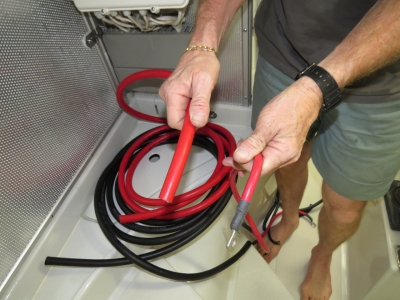 |
6/21/2014: Alternator cables
Position: -27°28.24'S, 153°2.32'E
The final phase of the start alternator paralleling project is to upgrade the start alternator from 85A at 24v to 190A at 24v and to install the heavier cabling required for the larger alternator.
|
 |
6/21/2014: Close one
Position: -27°28.24'S, 153°2.32'E
A reminder of the importance of electrical safety. With the amount of current moving around in a modern boat, all conductors must be of adequate size and all connections properly torqued. We had retorqued all connections behind all breaker panels, but hadn't done the DC panel since new. We found one conductor on the main DC bus a full turn loose and glowing red. In the picture, it's the one second from the bottom right where heat has destroyed the galvanizing. Loose connections are a serious fire risk. We've since retorqued them all and only the one was loose, but it's a reminder of the importance of checking all high-current connections every year.
|
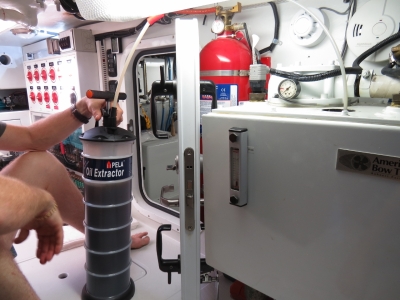 |
6/22/2014: Hydraulic oil
Position: -27°28.24'S, 153°2.32'E
Draining the hydraulic oil reservoir in preparation for removing the heat exchanger. Our ABT hydraulic system has operated without major issue for five years and continues to work well. Even though the heat exchanger installed is perfectly adequate, we're big believers that controlling hydraulic oil temperature is a great way to get longer hose and o-ring life. We're installing a roughly 50% higher-capacity heat exchanger so the oil continues to run nice and cool even in 80F or 90F water.
|
 |
6/22/2014: Old heat exchanger
Position: -27°28.24'S, 153°2.32'E
The old heat exchanger after removal. We'll keep it as a spare.
|
 |
6/23/2014: A-Zoom
Position: -27°28.24'S, 153°2.32'E
Lyle Stanaway, of A-Zoom Carpet Care, steam-cleaned our carpets this morning. They look and feel much better.
|
 |
6/23/2014: Refueling
Position: -27°28.33'S, 153°2.32'E
We'd taken a City Hopper back to Dockside from the CBD. Everyone was asked to disembark at our stop because the vessel needed refueling. Our City Hopper docked, unloaded its passengers, and stood off while a replacement took the dock and picked up the passengers. Then the two vessels rafted to swap skippers.
|
 |
6/24/2014: New Farm Vet
Position: -27°27.90'S, 153°2.61'E
Spitfire also was due for a teeth cleaning. The procedure is more time-consuming, and expensive, for pets as they must be anesthetized. New Farm Veterinary Surgery did a great job and took good care of him.
|
 |
6/24/2014: New heat exchanger
Position: -27°28.24'S, 153°2.32'E
The new heat heat exchanger in place. The original was four-pass with a four-inch diameter--this one is six-pass with a six-inch diameter. The install location is tight and a significantly larger heat exchanger that would still fit didn't exist. Sen-Dure came up with a design that's nearly 50% higher capacity and yet all the hoses and connections are very close to being in the same place.
|
 |
6/25/2014: Rivergate Shipyard
Position: -27°26.76'S, 153°6.27'E
At Rivergate Shipyard on a road trip with Mark from Gray Matter. Rivergate has an extensive shipyard--this 75-tonne TravelLifts is one of the shipyard's three lifts and is more than capable of lifting our 55-tonne boat.
|
 |
6/25/2014: 300 Tonne TravelLift
Position: -27°26.76'S, 153°6.27'E
The largest of the three TravelLifts at Rivergate can lift a whopping 300-tonne vessel. The shipyard specializes in Superyacht refits.
|
 |
6/25/2014: Black Jack
Position: -27°26.76'S, 153°6.27'E
The 20.2-meter Black Jack, on the hard at Rivergate Shipyard. The boat will be sailing in the upcoming Sydney Hobart race.
|
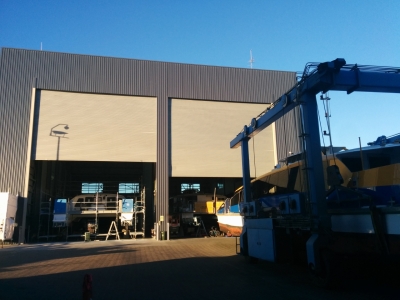 |
6/25/2014: CityCats
Position: -27°26.76'S, 153°6.27'E
The maintenance Facilities for the Brisbane City Council’s fleet of CityCats and Ferries also is at Rivergate, with a dedicated TravelLift.
|
 |
6/25/2014: Painting
Position: -27°28.24'S, 153°2.32'E
We painted the new heat exchanger with white Rustoleum.
|
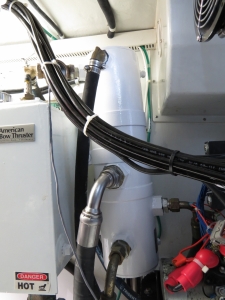 |
6/26/2014: Heat exchanger complete
Position: -27°28.24'S, 153°2.32'E
With a fresh coat of paint, the new heat exchanger installation is complete.
|
 |
6/29/2014: Wine tasting
Position: -27°28.24'S, 153°2.32'E
We bought a selection of New Zealand Marlborough wines from the local Dan Murphy's liquor store to taste. We'll stock up on the ones we liked best.
|
 |
6/30/2014: Marble Man
Position: -27°28.24'S, 153°2.32'E
We prefer a light-colored counter top, and marble was the only light-colored stone choice at the time our boat was built. Marble is not an ideal choice for the galley as it is prone to damage from acidic foods and scratches. But we like the color and it's worked out well for us. Early in the boat's life, a crack emerged at the narrowest part of the counter. We didn't think it was that obvious, but now that it's been repaired, it actually does make quite a bit of difference. Amil from the Marble Man patched the crack with pigmented epoxy.
|
 |
6/30/2014: Windlass service
Position: -27°28.24'S, 153°2.32'E
We last serviced the windlass in Hawaii--it's been a year, so it's due again. Today we drained the oil and refilled it with SAE90 gear lube, and also greased the top end.
|
 |
6/30/2014: Fuel fittings
Position: -27°28.24'S, 153°2.32'E
We just received new fuel fittings from the boat yard: SAE45 -12 field serviceable ends drilled for 1/8” NPT pressure sensors.
|
 |
6/30/2014: Pressure sensor
Position: -27°28.24'S, 153°2.32'E
We installed 0-3 psi pressure sensors to measure port and starboard fuel tank levels. For the past year we've used pressure-based fuel-level sensing in the supply and wing tanks and have found them remarkably reliable and accurate. When the boat was new, we installed ultrasonic sensors on the port and starboard fuel tanks. These were accurate when functioning, but were temperamental and often didn't work.
|
 |
7/1/2014: Bauer Junior
Position: -27°28.24'S, 153°2.32'E
Daryl Waters of Divetek Brisbane delivered our new Bauer Junior dive compressor today. The Bauer build quality is head-and-shoulders above the Max-Air, the service is far better, and they have a great reputation for longevity. And since the Bauer is easier to start, we get the added benefit of being able to run it off the 240v inverter. Overall, the Max-Air dive compressor was the worse $1,000 we ever saved.
|
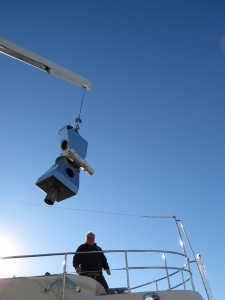 |
7/2/2014: A helping crane
Position: -27°28.24'S, 153°2.31'E
We relocated the boat temporarily this morning to be right beside Gray Matter without a finger pier in between so we could lift their nearly 500-pound davit base, rotation bearing and hydraulic rotation motor. Our crane's 16-foot reach just barely goes from the center of our boat to the center of Gray Matter where their davit is mounted. Read more ...
|
 |
7/2/2014: Junction box
Position: -27°28.24'S, 153°2.32'E
The patio heater branch circuit begins at this new junction box in the lazarette. It's the final stage of the patio heater install, and we're using it daily.
|
 |
7/3/2014: Anti-sooting fender
Position: -27°28.24'S, 153°2.32'E
The inside of the exhaust stack is coated with a thin layer of soot, top-to-bottom, adhering to the surface. If the engine is run hard, this layer is usually quite thin. If run lightly, as many trawler engines usually are, expect this coating layer to be thicker. But independent of the thickness, if the boat sits for a long period and rainwater tracks down the inside of the exhaust stack, each water drop that rolls down the stack carries soot with it and eventually dries at the bottom as a residual ball of soot. These balls are blown out with the exhaust and can make a mess. Sooting generally isn't an issue for us, but when the boat has sat for a while during rainfall, soot ejected on start-up can make a mess if not hosed off quickly. If soot spends time on the deck, or worse is ground in, removing it can be a real chore. If water doesn't get down the stack, the problem doesn't occur or is minimized. We've taken the most common solution: a cut-off fender that can quickly be dropped over the stack with a boat hook.
|
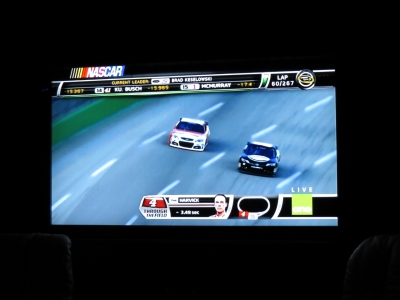 |
7/3/2014: NASCAR
Position: -27°28.24'S, 153°2.32'E
Stock car racing is popular in Australia, with the V8 Super Cars series being most closely followed and broadcast in over 100 countries. All the Sprint Cup Series NASCAR races also are available over our satellite TV system.
|
 |
7/5/2014: Voltage converters
Position: -27°28.24'S, 153°2.32'E
We've installed a 12v-to-12v power isolator to ensure all devices on the NMEA 2000 bus get nice, clean power. We've also voltage-isolated the 24v Furuno MFD black box.
|
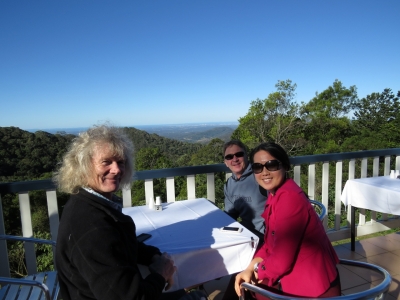 |
7/6/2014: Cloverlea Cottage
Position: -27°19.88'S, 152°45.54'E
Enjoying the view east to Moreton Bay from the deck at Cloverlea Cottage with our neighbours, Mark Mohler and Christine Guo of Gray Matter.
|
 |
7/7/2014: Ella's Pink Lady
Position: -27°28.91'S, 153°1.60'E
Australian Jessica Watson completed a non-stop solo circumnavigation at the age of 16. Her yacht, Ella's Pink Lady, now is on display at the Queensland Maritime Museum.
|
 |
7/7/2014: HMAS Diamantina
Position: -27°28.91'S, 153°1.60'E
The HMAS Diamantina is the Queensland Maritime Museum's centerpiece. The 91.7m vessel is the last surviving WW II river class frigate. This is a shot from the engine room--the vessel has two 5,500 hp triple expansion steam engines and had a top speed of 21 knots. Most of the vessel is open for self-touring.
|
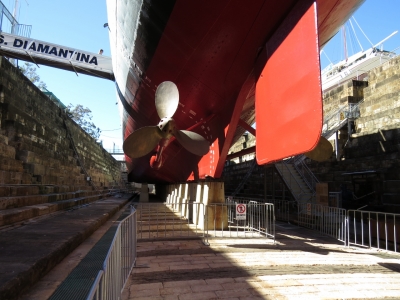 |
7/7/2014: Graving dock
Position: -27°28.91'S, 153°1.60'E
Underneath the HMAS Diamantina in the Brisbane Graving Dock. The dry dock opened in 1881 and operated until 1971.
|
 |
7/7/2014: Pump room
Position: -27°28.91'S, 153°1.60'E
Looking down into the pump room for the Brisbane Graving Dock. The black line near the bottom of the rightmost white post is the low tide line for the Brisbane River. The hight tide line is barely visible behind a crossbar above the printed sign. The pumps initially were steam-powered, then in 1924 electric motors were installed above this room to run the pumps via rope drive. One of the two rope drives is visible on the left of the picture, heading up to the electric motor.
|
 |
7/7/2014: Stokehouse
Position: -27°28.85'S, 153°1.54'E
Lunch riverside at the Stokehouse.
|
 |
7/11/2014: Groceries
Position: -27°28.24'S, 153°2.32'E
We're starting to stock up for the trip to the Whitsunday Islands and the Great Barrier Reef in early August. Woolworths delivers right to the boat, just like Amazon Fresh did in Seattle. Wonderful! We really missed that.
|
 |
7/12/2014: Dinghy seat
Position: -27°28.24'S, 153°2.32'E
Spitfire likes to sleep inside the dinghy under the cover, where temperatures get toasty-warm. We went looking for him this morning and noticed that cracks in the dinghy seat backrest hinge had worsened. We'd repaired these in the past, but they keep cracking in more places and the cracks were spreading. A new hinge is relatively inexpensive, and we've got two on order.
|
 |
7/12/2014: Fuel leak
Position: -27°28.24'S, 153°2.32'E
While working on the dinghy seat, we noticed a gasoline smell in the area. We pumped out the dinghy bilge with an oil extractor pump and found about a half-quart of gasoline. On further inspection, we could see a drip about every 60 seconds off the bottom of the tank, so it has to come out.
|
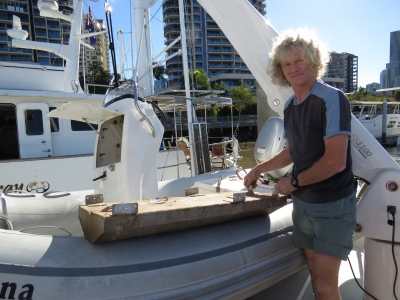 |
7/12/2014: Fuel tank
Position: -27°28.24'S, 153°2.32'E
A pinhole leak was in the tank base, and many more about to form, so we'll need to get a new tank. The leak is near the bilge water surface, where there is a potent combination of saltwater and oxygen exposure. But even still, six years isn't very long for the tank to have lasted. We'll try to replace it with a thicker aluminum fabrication and possibly get it painted.
|
 |
7/13/2014: Crane test
Position: -27°28.24'S, 153°2.32'E
Christine and Mark of Gray Matter testing out their new davit.
|
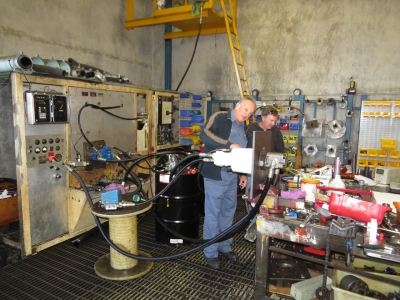 |
7/14/2014: Gateway Hydraulics
Position: -27°27.69'S, 153°6.50'E
Gateway Hydraulics did the new hydraulic power pack for Gray Matter. They're also building them a hydraulically-powered generator. Mark, on the right, is inspecting the work in progress. Gateway has a large and well-equipped shop, and their designs are simple and well-engineered.
|
 |
7/16/2014: Reinforcing bar
Position: -27°28.24'S, 153°2.32'E
We store 5-gallon pails of oil in the engine room stacked two-high. The stacks sit in a custom marine-board base with a matching top, and are secured with a ratchet-strap (see picture). The tie-downs were warping the tops, so we added these aluminum reinforcing bars to straighten and strengthen them. Ark Marine built the bars when we dropped off our leaking dinghy fuel tank for replacement.
|
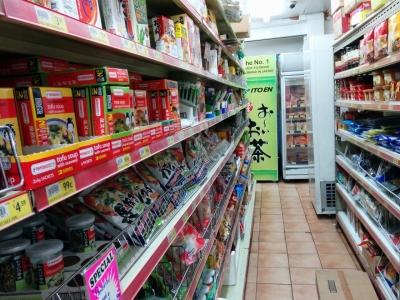 |
7/18/2014: Yuen's Market
Position: -27°27.52'S, 153°1.99'E
At well-stocked Yuen's Market in Brisbane's Chinatown to purchase powdered wasabi and other Asian products.
|
 |
7/18/2014: New gas tank
Position: -27°28.24'S, 153°2.32'E
Our beautiful new gas tank for the dinghy. Ark Marine did excellent work, and was amazingly fast. We dropped the old tank off on Tuesday and the new one was ready Friday morning. The old tank was 3mm, while the new one is 4mm plus a two-part epoxy coating--it definitely should outlast the dinghy. It probably will outlast most of civilization, to be found by archaeologists in the distant future.
|
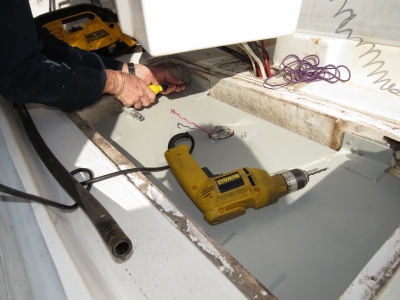 |
7/19/2014: Installing the new tank
Position: -27°28.24'S, 153°2.32'E
The new dinghy fuel tank in place. It fitted perfectly and the dinghy now is functional again. We were lucky to have found and solved the problem before we left for the Great Barrier Reef area.
|
 |
7/20/2014: Tie-downs
Position: -27°28.24'S, 153°2.32'E
Our SC30 satellite compass is mounted on a stainless-steel post that extends at a 90-degree angle from the top of our stack. If the post vibrates, this could damage the electronics in the SC30. To limit vibration, we ran wire cable from the either side of the spotlight under the SC30 back to the upper winglets and tighted the cable using turnbuckles.
|
 |
7/20/2014: Patio heater
Position: -27°28.24'S, 153°2.32'E
Enjoying the sunset in 60-degree weather under the new patio heater. The patio heater is completely amazing--we feel like we just nailed that one. A key advantage of the Heatstrip is a nice, even warmth with no red glow. You can't tell it's on and it doesn't change the lighting at night.
|
 |
7/21/2014: Dawn
Position: -27°28.24'S, 153°2.32'E
Dawn looking across the Brisbane River from our berth.
|
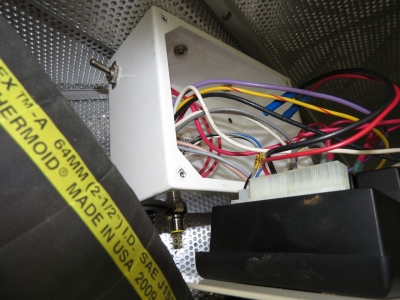 |
7/21/2014: Power switch
Position: -27°28.24'S, 153°2.32'E
Battery equalization is a process of partially restoring battery capacity by charging for a sustained period at higher voltage levels. This is a recommended periodic maintenance item for our Lifeline batteries--we choose do to it about every six months. The downside of this process is that it can expose sensitive electronic equipment to higher-than-normal voltage levels. As a consequence, we like to have the sensitive gear shut off or isolated. To make it easy to de-power our Wavenets during this process, we installed a switch (top left) in each.
|
 |
7/24/2014: School girls
Position: -27°28.24'S, 153°2.32'E
The Queensland School district calendar follows 10-week terms, with 4 terms a year. The third term started just over a week ago and we now frequently see groups of school-aged kids, usually in uniform, on or near the ferries.
|
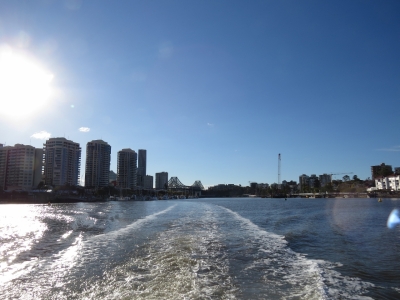 |
7/24/2014: CityCat
Position: -27°28.54'S, 153°2.50'E
Heading downriver by CityCat.
|
 |
7/24/2014: Oxford Street
Position: -27°27.03'S, 153°3.17'E
Sunset at The Jetty on Oxford Street overlooking the Bulimba CityCat dock. Oxford Street is full of restaurants, many with outdoor seating. After our sunset drink, we had an excellent meal streetside, with delicious lemon margaritas, at La Cantina Mexicana further up the road.
|
 |
7/27/2014: Brisbane from the air
Position: -27°29.07'S, 153°3.39'E
Looking down onto the Brisbane River on our flight out to Los Angeles. Dockside Marina, where we're moored, is at the left of the photo, just before the hairpin bend and Story Bridge. The Brisbane Central Business district is at the upper left.
|
 |
7/27/2014: Rous Channel
Position: -27°16.34'S, 153°24.26'E
Rous Channel, between Morteton and North Stradbroke Island. The waterway is buoyed and navigable, but is winding and quite shallow in parts.
|
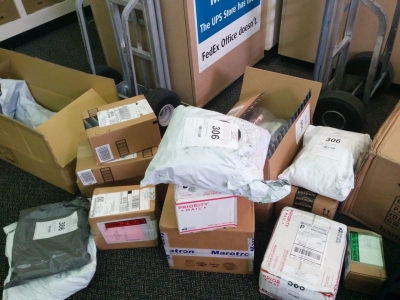 |
7/28/2014: Mail
Position: 47°36.21'N, -122°20.16'W
Picking up our mail and packages from our box at the UPS store to bring back with our luggage. We source items locally when we can, but anything 110V or 60Hz, such as an extension cord, must come from North America.
|
 |
8/1/2014: Virginia Inn
Position: 47°36.65'N, -122°20.56'W
At our favourite seat in the Virginia Inn: streetside with a view down Virginia Street across the Pike Place Market to Elliott Bay.
|
 |
8/7/2014: At the resort
Position: -27°44.78'S, 153°12.54'E
Spitfire at the window ledge between his room at "the resort" and the enclosed back deck where he spends much of his time bird-watching. "The resort" is Carmichaels Cattery--Sonia and Shane there are wonderful to work with and are taking excellent care of him while we're back in Seattle. And they even will chauffeur him from Dockside Marina and back.
|
 |
8/9/2014: Bell Harbor Marina
Position: 47°36.61'N, -122°20.80'W
Looking northwest into Elliott Bay across Bell Harbor Marina, our home port for several years and the last place Dirona touched Washington State before departing for San Francisco. Moored to Pier 66 outside the marina is the Norwegian Jewel, one of nine cruise ships departing Seattle this week for Alaska.
|
 |
8/12/2014: Reunited
Position: -27°28.24'S, 153°2.32'E
Everyone is happy to be back home on Dirona.
|